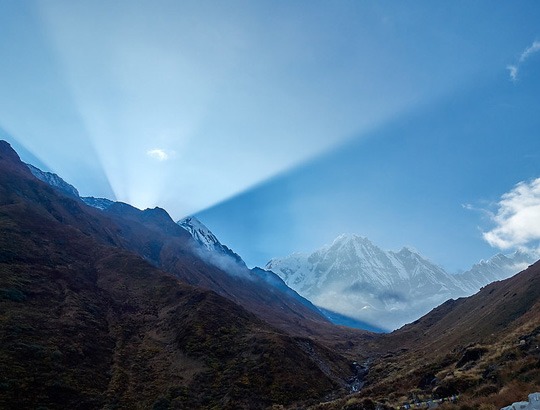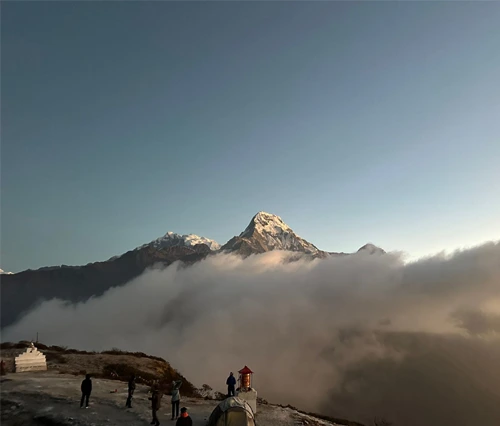Annapurna Region Treks
-

$420

Standard

Moderate

5
-


Standard

Strenuous

12 Days
-

$350

Standard

Easy

08
-


Standard

Strenuous

14 Days
-


Luxury

Easy

09 Days
-


Standard

Easy

13 Days
-


Standard

Moderate

06 Days
-


Standard

Trekking

10
Annapurna Region Treks
Annapurna region is proven as one of the best and famous trekking regions of the Nepal which provide spectacular geographical and cultural tour. Named after the Sanskirt term for ” Goddess of Harvests,” Annapurna is a highly auspicious name in Nepal. The area is characterized by the presence of some of the highest mountains in the world (e.g., Annapurna I (8,091 m), and it has the historic record of the first 8,000-meter-high mountain climb. However, outside the mountains, the Annapurna area provides terraced fields, mixed woodlands and vegetable gardens, pretty settlements and friendly hospitality from the indigenous Gurung, Magar and Thakali populations. Trekking here is more than just walking—it’s a journey through nature, culture, and tradition.
Annapurna Base Camp (ABC) Trek is an iconic trek that trekkers of all types enjoy. This trail leads you across fields, forests of vibrantly colored rhododendrons and quaint villages. The big highlight is reaching the Annapurna Sanctuary, where you’re surrounded by a circle of towering snowy peaks, including Annapurna I. During the trek, visitors can relax in natural hot springs at Jhinu Danda and visit Machhapuchhre Base Camp, literally at the foot of the sacred “Fishtail” mountain. Each stride of this trek is satisfying, and the scenes are eternally memorable.
Annapurna Circuit Trek is also a wonderful choice that leads you on a circular way round Annapurna range. The path begins in the green and vibrant town of Besishar and proceeds through the various landscapes to the iconic Thorng La Pass, which is 5,416 m high. Along the way, you’ll visit Muktinath, a holy site for Hindus and Buddhists. This walk is like one of travels through worlds—forested streams, windswept plateaus, and each day holds a new wonder to discover and revel in.
Khopra Ridge Trek is a superb option for those who prefer more tranquil trails. It’s less crowded but just as beautiful as the more popular routes. You’ll get incredible views of the Annapurna and Dhaulagiri mountains and visit Khayer Lake, a serene and sacred spot surrounded by mountains. By camping in community-based lodges during the trek, the hike feels friendly, and you’ll be able to contribute your visit directly to the local communities.
The Trekking of Ghorepani Poon Hill is suitable for those who have less time or are beginners. It is popular for a sunrise view that lightens the Annapurna and Dhaulagiri ranges into golden color. It has a very defined trail and passes through marvelous areas of rhododendron trees, little villages and cascading waterfalls. It is a short trek although it feels as challenging as the other one until you witness this sunrise!
For the seclusionist, the Mardi Himal Trek is off the beaten track. This trail leads you right up to Mardi Himal and Machhapuchhre’s breathtaking beauty, with views that are awe-inspiring and crowd-free. It is relaxing to trek, and teahouses during the trek are comfortable and friendly. It’s a perfect option if you are looking to enjoy the outdoors and get away from the more popular routes.
But there is much to do in the Annapurna region beyond the surrounding treks. When spring arrives, the hills sing with rhododendron blossoms in all shades of pink and red. The villages are like something out of a fairytale, stone-paved paths, and old houses. The locals are tremendously hospitable, sharing tales of their daily lives and culture at times. Along the way, you’ll see fluttering prayer flags, ancient stupas, and quiet monasteries, all adding a spiritual touch to the journey.
To walk in this region is to experience an emotional roller coaster. Trekking is tiresome in the sense that you have to exert your muscles physically while on the other side you’re blessed with mouth-opening beautiful view. A sunrise from the crest of a mountain when the snow-capped mountain peaks turn into silver, the sound of a river gurgling through a valley or the simple pleasure of having tea in a village or some such place leaves a memory for ever. Let’s not call it a trek because it is much more than that: a relation between man and nature, man and other, and man and himself.
Whether you’re an experienced trekker or someone trying it for the first time, the Annapurna region is for everyone. It is a place where adventure and the sublime intersect in the most profound way. The paths call out to you, to discover, to create memories that will last a lifetime. You want an adventure that speaks to your spirit, then the Annapurna region is waiting to welcome you.
Do not worry about these permits, as we at Himalayan Trekking will get all your permits for you.
© 2025 - Himalayan Trekking and Tours (P) Ltd. All Rights Reserved.

